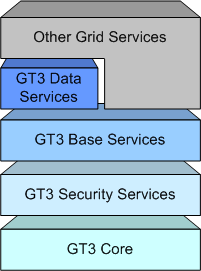Grid Services sound great, don't they? However, if you've already programmed grid-based applications, you're probably thinking that this is all very nice, but hardly enough for The Grid. Grid Services are only a small (but important!) part of the whole GT3 Architecture, which offers developers plenty of services to get serious with Grid programming.

OGSI (i.e. "Grid Services") is the 'GT3 Core' layer. Let's take a look at the rest of the layers from the bottom up:
GT3 Security Services: Security is an important factor in grid-based applications. GT3 Security Services can help us restrict access to our Grid Services, so only authorized clients can use them. For example, we said that only our New York, Los Angeles, and Seattle offices could access MathService. We want to make sure only those offices have access to MathService. Besides the usual security measures (putting the web server behind a firewall, etc.) GT3 gives us one more layer of security with technologies such as SSL and X.509 digital certificates.
GT3 Base Services: This layer actually includes a whole lot of interesting services:
Managed Job Service: Suppose some particular operation in MathService might take hours or even days to be done. Of course, we don't want to simply stand in front of a computer waiting for the result to arrive (specially if, after 8 hours of waiting, all we get might simply be an error message!) We need to be able to check on the progress of the operation periodically, and have some control over it (pause it, stop it, etc.) This is usually called job management (in this case, the term 'job' is used instead of 'operation').
Index Service: Remember from A short introduction to Web Services that we usually know what type of Web Service we need, but we have no idea of where they are. This also happens with Grid Services: we might know we need a Grid Service which meets certain requirements, but we have no idea of what its location is. While this was solved in Web Services with UDDI, GT3 has its own Index Service. For example, we could have several dozen MathServices all around the country, each with different characteristics (some might be better suited for statistical analysis, while others might me better for performing simulations). Index Service will allow us to query what MathService meets our particular requirements.
Reliable File Transfer (RFT) Service: This service allows us to perform large file transfers between the client and the Grid Service. For example, suppose we have an operation in MathService which has to crunch several gigabytes of raw data (for a statistical analysis, for example). Of course, we're not going to send all that information as parameters. We'll be able to send it as a file. Furthermore, RFT guarantees the transfer will be reliable (hence its name). For example, if a file transfer is interrupted (due to a network failure, for example), RFT allows us to restart the file transfer from the moment it broke down, instead of starting all over again.
GT3 Data Services: This layer includes Replica Management, which is very useful in applications that have to deal with very big sets of data. When working with large amount of data, we're usually not interested in downloading the whole thing, we just want to work with a small part of all that data. Replica Management keeps track of those subsets of data we will be working with.
Other Grid Services: Other non-GT3 services can run on top of the GT3 Architecture.